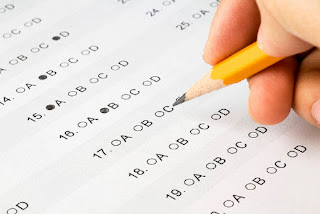Assessments
Throughout 20th century, classroom
assessment was considered a mechanism for learning. It also followed a
predictable pattern that teachers taught, tested the students’ knowledge of the
material, made judgements about students’ achievement based on the testing, and
then moved on to the next unit of work. More recently, however, this approach
to assessment has come into question as the expectations for schooling have
changed, cognitive research has provided new insights into the nature of
learning, and the traditional role of assessment in motivating student learning
has been challenged.
In
the article "Rethinking Classroom Assessment with Purpose in Mind" (2006)
it begins by describing how in the past, schooling beyond basic skills and
knowledge was viewed as optional and not required. But now, high school
graduation is considered a necessity for all, and the educational community is
being asked to guarantee that graduates be proficient in complex critical
thinking, problem-solving, and effective communication to meet demanding
societal, economic, and technological challenges (2006).
The second
interesting point made I found in the article is that learning was thought to
be an accumulation of bits of knowledge that are put in order, hierarchical,
and need to be explicitly taught and reinforced. Learning is now viewed as a
process of constructing understanding, during which individuals attempt to
connect new information to what they already know, so that ideas have some
personal coherence. Individuals construct this understanding in different ways,
depending on their interests, experience, and learning styles.Lastly, the article points out is that educators have traditionally relied on assessment that compares students with more successful students as a way to motivate students to learn. However, recent research suggests students will likely be motivated and confident learners when they experience progress and achievement, rather than the failure and defeat associated with being compared to more successful peers (2006).
How have assessments changed from when you were in school
to what we use today?
Formal and informal assessment of learning has always been
part of education. At the turn of the 20th
century, children were expected to attend school to learn basic skills.
Assessment was the tool for making decisions about future programs, and for
providing information to parents about their children’s learning.
Around the middle of the 20th century it became clear that
schooling was an important key to social mobility and that achievement in
school was the basis for entry into the workplace. Tests and exams took on
major importance in determining which students would have access to higher
education. Many jurisdictions instituted standardized testing programs
alongside classroom assessment to ensure fair, accurate, and consistent
opportunities for students.
Since the 1960s and 1970s, the purposes for classroom
assessment have grown. The terms formative assessment and summative assessment entered
into the world of education—formative assessment being assessment that takes place
during teaching to make adjustments to the teaching process, and summative
assessment being assessment at the end of a unit or term to convey student
progress. In order to fulfill these two purposes, educators extended their
assessment practices and began assessing a wider range of student work, such as
practical tasks, coursework, projects, and presentations. However, assessment
was still a matter of making statements about students’ weaknesses and
strengths.
How has technology helped to produce change?
By using technology to sort and organize data, teachers are better able to analyze individual and entire classroom data and then use that data to immediately help students.
Which types of
assessments are aided by technology?
Computer Aided Assessment can be used to provide a range of assessment types including summative (in which the mark contributes to a course result), formative (which provides a learning experience which is not graded), diagnostic (by which a teacher can assess the current understanding of students), and self-assessment (to provide the student with a measure of their own understanding).
A wide variety of tools are available to enable tests and quizzes to be delivered online. Some are provided as services supported by the schools, while many more can be found on the Internet. The tool that will be most useful to the educator varies depending on the context in which it is used and the outcomes required. For example, a survey tool is used for data collection which only collects the responses to questions and provides no feedback to those answering the questions. This is fine for diagnostic tests where a teacher wishes to assess the level of understanding their students may have before and/or after a teaching session or course.
Effective assessments give students feedback on how well
they understand the information and on what they need to improve, while helping
teacher’s better design instruction.
Authentic assessment can include many of the following
(2008):
- Observation
- Essays
- Interviews
- Performance tasks
- Exhibitions and demonstrations
- Portfolios
- Journals
- Teacher-created tests
- Rubrics
- Self- and peer-evaluation
Edutopia (2008). What are some types of assessment? Edutopia. Retrieved April 22, 2012 from http://www.edutopia.org/assessment-guide-description
Manitoba Education, Citizenship and Youth (2006). Rethinking
classroom assessment with purpose in mind. Manitoba. Retrieved April 22, 2012 from http://www.edu.gov.mb.ca/k12/assess/wncp/


No comments:
Post a Comment